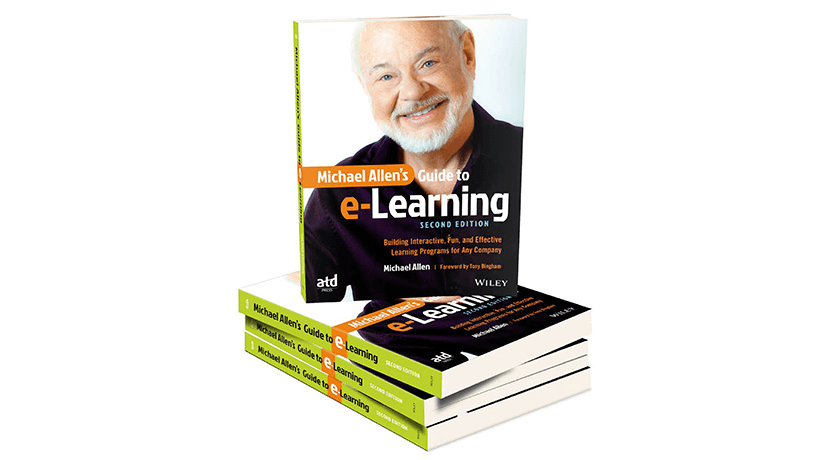Diving Into Learning Individualization And Iterative Design With Michael Allen
Dr. Michael Allen is the CEO of Allen Interactions Inc. and is considered the godfather of eLearning. He has over 45 years of professional, academic, and corporate experience in teaching, developing, and marketing interactive learning and performance support systems. Dr. Allen also holds M.A. and Ph.D. degrees in Educational Psychology from The Ohio State University and is an adjunct Associate Professor at the University of Minnesota Medical School in the Department of Family Medicine and Community Health. Today, he sheds more light on SAM and how to personalize the learning process.
With over 45 years of experience, you're known as the godfather of eLearning. What do you think is the biggest challenge facing new learning professionals now and can you offer some sage advice?
Learning professionals are routinely asked to work magic. Highly effective learning experiences are meaningful, memorable, and motivational. You don't often get them from sticking content into a form or template, yet learning professionals are often expected to complete their work quickly while keeping costs to a minimum. I'm always working to get organizations to look at their training as an investment to improve their productivity or competitiveness. It seems we're making a little progress, but to the extent training is viewed as a cost, which is always viewed as something to be minimized, design and development funding isn't likely to support the work necessary for the greatest ROI.
Sage advice: I can't stress strongly enough the advantages of using the Context, Challenge, Activity, Feedback (CCAF) model. This approach (described below) helps us deal with the excessive content typically dumped on us (while also not providing all the content we really need), the tendency to focus on content presentation (which produces boring, passive learning), the need for learner engagement (which happens only when learners see the relevance and advantages of learning the skills being taught), and the challenges of individualizing the learning experiences (one size never fits all).
You helped to develop the SAM process for iterative, collaborative development. In your opinion, what is the most common misconception about SAM and how can it help L&D designers create memorable experiences?
Perhaps the most common misconception is that SAM is pretty much ADDIE with some iteration thrown in. I used to teach ADDIE at the graduate level and practiced it myself. I know it well—its pros and cons. It's logical and comprehensive. But also tedious and time-consuming. Out of necessity, most teams take shortcuts to save time and energy, but even then, ADDIE tends to focus much more on content preparation than on learners and the learning experience.
SAM encourages a very different perspective, flipping the focus to creating experiences that adapt to learners. Instead of addressing the broad question of, "What should we do to teach XYZ?", SAM repetitively throws out ideas for learning events and asks for each idea, "Why shouldn't we teach this way?" If we need to do some analysis to answer this question, we do it then, purposely, with the intent to answer this specific question. It's more effective and efficient than doing an unbounded time- and effort-consuming analysis. When we feel we've identified the right learning experiences, we then go after the subject matter/content we need to make them as authentic as possible. As we iterate, we're constantly looking to assure ourselves that we're addressing the essential behaviors that will lead to performance success post training. We're not asking, "How can we present all the content in an interesting way and lose focus on creating memorable experiences?".
What do you think is the most significant cognitive hurdle organizations must overcome when delivering online training experiences?
The existential differences between classroom/instructor-led training and the advantages and disadvantages of each.
This misconception leads to mimicking the classroom experience in online training, which builds on the weaknesses of the classroom and restricts online learning to its weaknesses. It combines the weaknesses of both and excludes the advantages of each. It's the worst possible outcome.
Online learning lacks the ability of an instructor to observe students closely—to read their non-verbal communications, including frustration, lack of focus, desire to engage in conversation, or need for motivation and inspiration. But classroom-based learning must generally assume all learners are novices at the start and focus all learners on content that may be well-known to some—if not many—students. Individualizing the experience is very difficult in classrooms, if possible at all. As the number of students grows, the possibility vanishes.
While eLearning gets support from being less expensive to deliver, convenient to access, and unlimited in the number of learners it can serve simultaneously, the super strength of eLearning is its ability to individualize the training experience. Each learner's path might actually be unique if eLearning is designed to be sensitive to the learner's developing abilities and needs.
Is there a recent development project, product launch, or another initiative our readers should know about?
So many exciting things are happening, it's hard to pick one. Overall, I'm always looking for ways to make eLearning more personal and adaptive. I like to think about what a good personal mentor would do and model after that.
So, one thing I'm very excited about is what we call the Learner's Constellation. It allows us to ask our learners about who they are, what skills they have, what skills they'd like to have, and even the way they like to learn. For example, do they like to take on difficult challenges just to see how they might do? Or do they like to take small steps building up to progressively greater challenges?
It's occurred to me that, while a good mentor would always try to get to know a student and consider how best to help, we pretty much never do that in eLearning. But we could! And the Constellation makes it easy for us to do, while also making it fun for the learner to provide the information.
The Constellation mechanism we've built allows us to quickly list any skill, interest, need, and preference we would like to know about. Each item is presented as a possible star in the Learner's Constellation. Learners then slide the stars about, moving those attributes that are strongest toward the center, so they most visually define the learner. If a star is moved very far away, it can be absorbed by a "black hole" to indicate it just doesn't apply at all. We can learn things such as how eager the student is to learn from this course, what concerns might exist, what skills might need only to be verified rather than taught, etc.
I think this approach begins to fulfill the promise and potential of online learning.
What excites you most about the future of eLearning, particularly in the realm of Instructional Design?
In my most recent work, I'm exploring the capabilities of making eLearning sensitive to how learners are feeling. How do they assess their developing skills? How confident do they feel? Do they want to take on greater challenges moving forward? Would they like more practice or more examples? Do they doubt their abilities to become successful performers in the area addressed by the course? Are they fearful of failure in the course, just disinterested, or terribly pressed for time?
In eLearning, we can respond to these feelings and situations if we (a) assess them so we know how learners are feeling and (b) have the means to respond to them. Good mentors ask, assess, and adjust. These are things eLearning can do as well. There are many ways to build fitting responses, but I'm finding the CCAF model helps here. I'll describe this as briefly as I can, but for more depth I've blogged on this at AllenInteractions.com, made many presentations, and have a LinkedIn Learning course on it.
With CCAF, right out of the box we set a context for the learner—a situation or place the learner can readily imagine being in: the reception desk at a dental office, a homeowner reporting birds in the attic, an airport under attack. We then present a challenge which asks the learner to solve a problem or perform a task to a defined level of efficiency. The learner now knows what the course is all about, far more explicitly and interestingly than a list of formal learning objectives. We then ask for activity, usually through various mouse gestures representing actions the learner wants to take. We work to make the activity feel as authentic as possible rather than like answering questions or selecting among a list of multiple choices.
The feedback is the primary channel for instruction. Wherever possible, the feedback should present the consequences of the learner's actions. Sometimes, showing consequences is fully sufficient, especially for advanced learners. More novice learners may need and benefit from instructional content as well. Delivering it at this point instead of up front allows the instructional content to be based on the learner's assessed performance (and not on an assumption that the learner doesn't know anything).
CCAF generally works as a loop such that, after feedback, the learner may continue working to meet the current challenge, progress to a more difficult challenge, or move on to another context. Here's what's particularly exciting: if we ask how the learner is feeling at this point, the choice of how to loop or advance can be based on not only the performance of the learner but also on how the learner feels. The learner may have taken the correction action but feel like it was a lucky guess and not feel confident that necessary skills are mastered. What a great thing to know, right? So, just moving on wouldn't be a great option. Let's give the learner more practice opportunities to build that confidence.
It's so exciting to find practical ways to make learning events more respectful of learners and more responsive to their needs. Learners will stay more engaged if their journey is mapped uniquely on who they are. And we can be much more certain our training will achieve the performance results needed if our trainees are not only competent in their skills but also confident in their ability to perform them.
Wrapping Up
A big round of appreciative applause to Michael Allen for participating in our Thought Leader Q&A. Michael was also featured on our eLearning Trailblazers [2022] list for his decades-long commitment to Educational Psychology and ID innovation.








